Multimedia
Navigating Geopolitical Shifts: Strategies for Ports in an Uncertain World

Partnered by:

Ports around the world serve as key connectors that support the economic and social development of countries and continents. In an era of ever-changing international relations, it has become paramount for ports to adapt and emphasize the role of international partnerships. In 2022, AD Ports Group undertook a commitment to yielding remarkable results and extending its international reach — fostering collaboration between global ports, stakeholders and regulators to mitigate the impact of geopolitical shifts on global trade. Consequently, 2022 emerged as a pivotal year in the company’s storied history. Forging new partnerships and shipping routes, AD Ports Group is developing high levels of connectivity between the Gulf, Indian Ocean, Red Sea, East Africa and Central Asia. Through acquisitions, major port projects, infrastructure agreements, and the establishment of new logistics and freight businesses, AD Ports Group has transformed into a bridge linking Abu Dhabi to the world.
This hourlong webcast, the first of a two-part series, will explore the recent innovation and developments that have facilitated AD Ports Group’s remarkable global expansion, to become one of the premier ports in the Middle East and worldwide.
Moderator: Alessandra Barrett, Associate Director, Special Projects, Journal of Commerce, S&P Global
Speakers: Julian Skyrme, Vice President Commercial Port Cluster, AD Ports Group Ross Thompson, Group Chief Strategy and Growth Officer, AD Ports Group
*Check back soon for more information! For more information, please visit https://subscribe.joc.com/mediasolutions/
Mastering Drayage in the Digital Age: Real-Time Insights and New Integrations

Partnered by:

In the fast-paced world of logistics, staying ahead requires more than just moving goods from point A to point B. It demands a deep understanding of your operations, real-time insights, and seamless integration capabilities. Join Lisa Wan Executive VP of Operations with Roadex America and Toni Careccio Chief Customer Officer with PortPro as they discuss these challenges and solutions and take questions from the audience. The conversation will address:
• Increasing efficiencies with real time tracking of drivers and containers • Improving customer relationships with effective customer portals • Saving valuable time with increased system integrations
Moderator: Ariane Pepsin, Senior Associate Editor, Special Projects, Journal of Commerce by S&P Global
Speakers: Toni Careccio, Chief Customer Officer, PortPro Lisa Wan, Executive VP, Operations, RoadEx CY
*For more information, please visit https://subscribe.joc.com/mediasolutions/
Take Collaboration to the Bank: Enhancing Drayage to Save Costs

Partnered by:

Better data yields quicker answers. To make a significant impact, however, the information must be real time and provide the visibility to accurately connect all links of your supply chain. When the drayage step includes partnership with steamship lines and port authorities, vessel insight brings the picture into sharper focus. Tech platforms take us to a point, but collaboration across modes brings the data to life in an actionable way. When line-down situations and late fulfillment of product can cost companies millions, time does mean money. Tracking from origin through final mile and down to the container return translates to savings at the classic pain points. Informed decision-making results in on-time delivery, faster fulfillment to end users, and reduced downtime for manufacturers.
This webcast will examine the steps that take industry collaboration from a vague idea to a significant savings on your freight bill.
Moderator: Alessandra Barrett, Associate Director, Special Projects, Journal of Commerce by S&P Global
Speaker(s): Brian Kempisty, Founder, Port X Logistics
*For more information, please visit https://subscribe.joc.com/mediasolutions/
Midyear Breakbulk and Project Cargo Report: MPV Fleet Update and the Second-Half Outlook

Multipurpose and heavy-lift charter rates have drifted lower but stabilized over the summer even as long-term carrier sentiment remains positive, supported by a healthy demand outlook and tightening capacity. While the minor bulk trades are seeing limited activity, cargo related to industrial and infrastructure-related markets has begun to pick up momentum. What can cargo shippers and logistics service providers expect as we move into the second half of 2023?
This midyear breakbulk and project cargo outlook webcast will examine fleet supply, fleet makeup and the demand picture, as breakbulk and project cargo research analyst Susan Oatway presents the findings of the first Journal of Commerce Breakbulk Quarterly Report. Industry executives will join the session for an in-depth discussion of the report’s implications.
Moderator: Janet Nodar, Senior Editor, Breakbulk, Project, and Heavy-Lift Shipping, Journal of Commerce by S&P Global Speakers:
Linda Driscoll, Transportation and Logistics Advisor, NOV Completion and Production Solutions
Susan Oatway, Research Analyst-Project and Breakbulk Cargo, Journal of Commerce by S&P Global
Felix Schoeller, Commercial Director and a Board Member, AAL Shipping (AAL)
*Check back soon for more information! Interested in sponsoring this webcast? For more information, please visit https://subscribe.joc.com/mediasolutions/
European Shipping and Trade Outlook: The Trans-Atlantic

"The trans-Atlantic party is over” was how Alphaliner described the trade lane in one of its recent weekly newsletters. It certainly marks the end of a wild three-year ride during which rates from North Europe to North America climbed steadily past $8,000 per FEU in the last quarter of 2022, and then fell off a cliff. The westbound trans-Atlantic was the last of the big east-west corridors to be “normalized,” but it has been a particularly hard reset in the last seven months. By mid-August, short-term rate levels were half those recorded in pre-pandemic 2019 as low demand from US importers and an oversupply of vessels undermined prices. Carriers began to withdraw capacity this summer, led by service cuts from Mediterranean Shipping Co., but either the capacity cuts have not been sufficient, or a lag effect means the impact on volume has yet to be seen. Data from PIERS, a sister product of the Journal of Commerce within S&P Global, shows US imports from North Europe have declined every month since January, with May and June both reporting a 17% drop in year-over-year volumes. US imports from the Mediterranean showed even sharper declines, falling 21% year over year in May and 24% in June. Although no volume data is available yet for July, rate levels continued to fall through August, with some rate indices noting spot prices dropping below $800 per FEU, indicating a continuation of the supply-demand imbalance. With too much capacity and no sign of rising demand, what is the outlook for the trans-Atlantic westbound trade? Should shippers prepare for an extended period of service cuts, blank sailings, and disruption as carriers impose more aggressive capacity-management measures to rein in the tumbling rates?
This complementary hourlong webcast will explore what cargo owners on the trans-Atlantic can expect through 2023 and into next year.
Moderator:
Greg Knowler, Europe Editor, Journal of Commerce by S&P Global
Speaker(s):
Pasquale Formisano, Senior VP and Head of Europe to North America Trade, MSC
Jochen Gutschmidt, Senior Advisor-Inland Supply Chain and Logistics, Lidl
Markus Panhauser, Senior Vice President-Ocean Freight Europe, DHL Global Forwarding
Stefan Verberckmoes, Senior Analyst, AXS Marine
*Check back soon for more information!
Interested in sponsoring this webcast? For more information, please visit https://subscribe.joc.com/mediasolutions/
Recent News and Analysis
Maritime News
- Maersk picks new CFO, reshuffles some regional chiefs
- Inland rail connectivity key to Port of Long Beach growth: new CEO
- Australian government action needed to curb soaring terminal charges: regulator
- Hapag-Lloyd to expand feeder fleet with new methanol-ready ships
- NYK, MOL to pay $72 million to settle UK vehicle shipment claims
Surface News
- Reliance on contracts results in unused truckload, ocean capacity: study
- US truckload rates jump on poor weather, shorter holiday shopping season
- Rail service shakes off prior disruptions to close 2025 on high note
- AI will change UP-NS merger review in ways the industry has never seen
- Broker association to aggregate truckload theft, fraud information for FBI
Air Cargo News
- Black Friday demand tightens trans-Pacific air cargo capacity, elevates rates
- DHL Global Forwarding sees Q3 revenue drop on lower ocean rates
- Belly freight shouldering airlines’ CO2 emissions burden: forwarders
- Air freight growth remains solid as verticals support nonstop momentum
- Expeditors’ Q3 earnings beat forecast on air freight, customs gains
Supply Chain News
- CargoWise’s pricing model change could mark final milestone in market ascent
- Reliance on contracts results in unused truckload, ocean capacity: study
- Transfix targets ‘unbundled’ chaos of truckload brokerage with TMS product
- Vancouver’s new scheduling system gives 96-hour advance notice of vessel arrivals
- Broker association to aggregate truckload theft, fraud information for FBI


